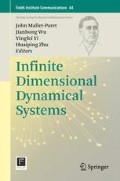Abstract
Reaction-diffusion models have been widely used to describe the dynamics of dispersing populations. However, many organisms disperse in ways that depend on environmental conditions or the densities of other populations. Those can include advection along environmental gradients and nonlinear diffusion, among other possibilities. In this paper I will give a survey of some models involving conditional dispersal and discuss its effects and evolution. The presence of conditional dispersal can strongly influence the equilibria of population models, for example by causing the population to concentrate at local maxima of resource density. The analysis of the evolutionary aspects of dispersal is typically based on a study of models for two competing populations that are ecologically identical except for their dispersal strategies. The models consist of Lotka-Volterra competition systems with some spatially varying coefficients and with diffusion, nonlinear diffusion, and/or advection terms that reflect the dispersal strategies of the competing populations. The evolutionary stability of dispersal strategies can be determined by analyzing the stability of single-species equilibria in such models. In the case of simple diffusion in spatially varying environments it has been known for some time that the slower diffuser will exclude the faster diffuser, but conditional dispersal can change that. In some cases a population whose dispersal strategy involves advection along environmental gradients has the advantage or can coexist with a population that simply diffuses. As is often the case in reaction-diffusion theory, many of the results depend on the analysis of eigenvalue problems for linearized models.
Mathematics Subject Classification (2010): Primary 92D; Secondary 35K
Access this chapter
Tax calculation will be finalised at checkout
Purchases are for personal use only
References
H. Amann, Dynamic theory of quasilinear parabolic systems III. Global existence. Math. Z. 202, 219–250 (1989)
H. Amann, Dynamic theory of quasilinear parabolic equations II: Reaction diffusion systems. Differ. Integr. Equat. 3, 13–75 (1990)
F. Belgacem, C. Cosner, The effects of dispersal along environmental gradients on the dynamics of populations in heterogeneous environment. Canadian Appl. Math. Quart. 3, 379–397 (1995)
R.S. Cantrell, C. Cosner, Spatial Ecology via Reaction-Diffusion Equations, Series in Mathematical and Computational Biology (Wiley, Chichester, 2003)
R.S. Cantrell, C. Cosner, D. DeAngelis, V. Padron, The ideal free distribution as an evolutionarily stable strategy. J. Biol. Dynam. 1, 249–271 (2007)
R.S. Cantrell, C. Cosner, Y. Lou, Movement towards better environments and the evolution of rapid diffusion. Math. Biosci. 204, 199–214 (2006)
R.S. Cantrell, C. Cosner, Y. Lou, Advection mediated coexistence of competing species. Proc. Roy. Soc. Edinb. 137A, 497–518 (2007)
R.S. Cantrell, C. Cosner, Y. Lou, Approximating the ideal free distribution via reaction-diffusion-advection equations. J. Differ. Equat. 245, 3687–3703 (2008)
X.F. Chen, Y. Lou, Principal eigenvalue and eigenfunction of elliptic operator with large convection and its application to a competition model. Indiana Univ. Math. J. 57, 627–658 (2008)
X.F. Chen, R. Hambrock, Y. Lou, Evolution of conditional dispersal: a reaction-diffusion-advection model. J. Math Biol. 57, 361–386 (2008)
C. Cosner, A dynamic model for the ideal free distribution as a partial differential equation. Theor. Pop. Biol. 67, 101–108 (2005)
C. Cosner, Y. Lou, Does movement toward better environments always benefit a population? J. Math. Anal. App. 277, 489–503 (2003)
J. Dockery, V. Hutson, K. Mischaikow, M. Pernarowski, The evolution of slow dispersal rates: a reaction-diffusion model. J. Math. Biol. 37, 61–83 (1998)
A. Hastings, Can spatial variation alone lead to selection for dispersal? Theor. Pop. Biol. 24, 244–251 (1983)
M.A. McPeek, R.D. Holt, The evolution of dispersal in spatially and temporally varying environments. Am. Nat. 140, 1010–1027 (1992)
Acknowledgements
Research partially supported by NSF grants DMS-0514839 and DMS-0816068.
Received 9/10/2009; Accepted 3/12/2012
Author information
Authors and Affiliations
Corresponding author
Editor information
Editors and Affiliations
Rights and permissions
Copyright information
© 2013 Springer Science+Business Media New York
About this chapter
Cite this chapter
Cosner, C. (2013). Beyond Diffusion: Conditional Dispersal in Ecological Models. In: Mallet-Paret, J., Wu, J., Yi, Y., Zhu, H. (eds) Infinite Dimensional Dynamical Systems. Fields Institute Communications, vol 64. Springer, New York, NY. https://doi.org/10.1007/978-1-4614-4523-4_12
Download citation
DOI: https://doi.org/10.1007/978-1-4614-4523-4_12
Published:
Publisher Name: Springer, New York, NY
Print ISBN: 978-1-4614-4522-7
Online ISBN: 978-1-4614-4523-4
eBook Packages: Mathematics and StatisticsMathematics and Statistics (R0)

